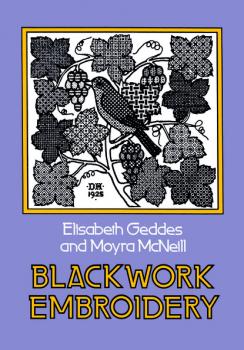Dover Embroidery, Needlepoint
Скачать книги из серии Dover Embroidery, NeedlepointEncyclopedia of Embroidery Stitches, Including Crewel
Let one of the most accomplished and creative crewel and embroidery experts into you home to teach you the ABCs of these increasingly popular handicrafts. Just turn the pages of this encyclopedic handbook and you will find her precise explanations and clear illustrations on how to work 178 different stitches and their variations.Logically organized for easy use, the book is divided into ten sections. Each is devoted to one of the basic families of stitches, differentiated from the others by its own distinctive motion. Taking one family at a time, the author classifies its various stitches into different groups — such as isolated, isolated variations, line, angled line, grouped — and explains them in their order of difficulty. The clear, lucid text and carefully drawn diagrams — over 1,400 in all — together present the step-by-step working of each stitch. Illustrations of both the front and back of finished stitches are included.Among the 178 stitches in such families as chain, straight, knotted, couched, and woven, are such variations as the Bosnian, Cable Outline, Whipped Satin, Lazy Daisy, Eyelet Buttonhole, Double Feather, Palestrina, Raised Lattice Band, and scores of others. In addition to the detailed working instructions, the author notes the basic rhythm of each stitch, direction of work, appropriate uses, and other pertinent information.This is an excellent workbook for all who want to learn these highly creative and satisfying stitches, and an ideal refresher course and reference for more experienced needleworkers.
Blackwork Embroidery
Blackwork embroidery was very popular in Tudor times, and it is now enjoying a tremendous revival. A form of counted-thread work, blackwork emphasizes shading contrasts that are possible working with a single color of thread. This book is one of the best modern works on blackwork. After covering the intriguing history of blackwork in a lively text and beautiful selection of illustrations, the authors present every aspect of the modern techniques and uses of the craft.There is a discussion of contemporary techniques of transferring a design, stitches, needles, and more; information on how to make a design, including numerous illustrations of examples such as birds, animals, fruit, architectural forms, an angel, a crusader, and more; over 200 illustrations of embroidery patterns, including simple, filling, and border patterns; and coverage of materials and threads with full charts. A new Publisher's Note gives a listing of current American suppliers.Done in black silk on white linen, blackwork was originally used to decorate clothes and household articles. Today, you can still produce effective decorations in black-and-white, but many projects will look even better done in color. You can use blackwork on towels, tablecloths, sheets, and clothes, and you can make very attractive blackwork designs for wall hangings and pillows.
Victorian Fancy Stitchery
This exceptionally fine needlecraft guide from the turn of the twentieth century includes instructions for projects that range from drawn-thread work — one of the oldest and simplest forms of art needlework — to the attractive novelty of bead embroidery on netting.Abundantly illustrated directions for «fancy stitchery» also provide tips for such exquisite creations as reticella lace and Venetian crochet, elegant hardanger and hedebo work, macramé, cross-stitch, ancient cut-work, and embroidery on flannel.A useful manual for anyone who enjoys re-creating needlecraft projects from an earlier era and a valuable reference for collectors of antique laces and dress trimmings, this volume also provides a captivating glimpse of needlework from a bygone era.


